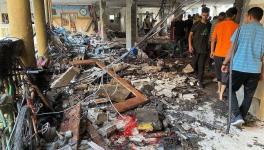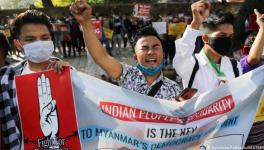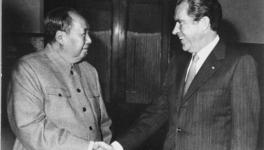Much Ado about North Korea’s Nuclear Test
After threatening for quite some time to do so, North Korea carried out a third underground test of a nuclear device on its own territory just a few days back.
Predictably, this blatant act has led to wide-spread condemnation by the international community, more strongly by some North American and Western European countries than others. There are all sorts of threats being conveyed of much tougher sanctions—economic and of many other kinds—than have already been imposed against N. Korea since 1993. What is interesting and ironic is that these threats are emanating mainly from countries which have been armed to the teeth with powerful nuclear weapons for a long time and also have highly developed means of delivering them over long distances, including over North Korea. Their claimed high moral grounds and the associated hypocrisy and double-speak this state of affairs reveals is mind-boggling to say the least.
The known nuclear powers in our precarious world, in addition to N. Korea, are China, France, India, Israel, Pakistan, Russia, the United Kingdom, and the United States. Most of them also have long-range ballistic missiles that can reach almost every spot on earth. Some who do not yet have such missiles are certainly on their way to developing and deploying them soon. Ironically also, among the existing nuclear powers, China, France, Russia, the United Kingdom, and the United States are the only veto-wielding permanent members of the United Nations Security Council which is the only international body mandated to ensure peace and security around the world! Under a NATO nuclear weapons-sharing agreement, the United States is reported to have also deployed nuclear weapons and delivery systems in Belgium, Germany, Italy, the Netherlands, and Turkey. Earlier, such weapons and systems were also based by the US in Canada (until 1984) and Greece (until 2001). Russia’s own nuclear arsenal was deployed in Belarus, Kazakhstan and Ukraine. Where else such weapons of mass destructions are still deployed is not known. What is known is that hundred, perhaps thousands, of nuclear weapons, not only Russian but others’ also, are floating around the world at this very moment on ships and submarines. They can all be launched at very short notice, even within minutes.
Let us not forget that the first underground test of a nuclear device in this troubled world of ours was carried out by the United States in 1945, which enabled her to drop two lethal nuclear bombs on Japan in the same year, killing and seriously injuring hundreds of thousands of innocent men, women and children. Many more underground atmospheric tests were carried out afterwards. Not till 1991 did the US stop underground nuclear tests, not before developing more and more sophisticated and destructive nuclear weapons, including the hydrogen bomb. The Soviet Union (now Russia) carried out the first test in 1949, stopping testing only in 1990. The UK’s first test was in 1952, further tests continued till 1991.In the case of France, the testing period lasted from 1960 to 1996. Tragically some French tests were carried out outside her own territory, making some islands inhabitable for thousands of years to come... China began nuclear testing in 1964 and did not stop till 1996. At the height of the so-called “cold war”, the US was reported to have 32,000 nuclear weapons of all types and the Soviet Union 45,000. These weapons could have destroyed all human and other life on earth more than a thousand times. Adding to this, the huge arsenal developed and deployed by China, France and the United Kingdom in the post World War II era one gets a better idea of how fragile our small planet has been and still is today because many of these weapons still exist.
India’s nuclear weapons program began in the late 1960s; she carried out the first test in 1974. In 1998 India carried out five underground tests. These were followed immediately by three similar tests by Pakistan. Despite all sorts of threats of sanctions by France, Germany, the US and USA, neither country was deterred nor did it suffer any serious sanctions or other adverse consequences. Since then, both countries are reported to have stockpiled 50-100 atomic weapons each. In India’s case, the Unite States and some other nuclear technology suppliers have even been competing to sign very lucrative contracts for selling her the latest nuclear plants.
Despite the secrecy surrounding all such data the Ploughshares Funds estimates there are today close to 17,300 nuclear weapons, stockpiled and floating around the world: Russia 8,500, the US 7,700, France 300, China 240, the UK 225, Pakistan 90-110, India 80-110, and Israel 60-80. Poor N .Korea only has less than 10 of them!
The main argument and justification the existing nuclear powers offer for developing, stock-piling and deploying very deadly atomic weapons is that they serve as deterrents against the use of such weapons against them by one or more hostile powers. We have to ask: If that is a valid justification, then why shouldn’t N. Korea have them also? After all, as the old saying goes (not verbatim) “there are no permanent friends, only convenient bed-fellows” when it comes to international politics. N. Korea is surrounded by several potentially hostile powers which are located not too far away from its territory, especially in the age of intercontinental ballistic missiles. These powers include: China, Russia, India and Pakistan. Iran may also one day join these near and distant neighbours. Then there are the United States, the United Kingdom and France which can annihilate N. Korea in minutes with their land and ocean-based atomic weapons and missiles. No one knows for sure how many of such weapons and delivery mechanisms are also secretly base in Japan, Taiwan, and other neighbouring countries by their friends and protectors. Let us also not forget Israel which can deliver massive deaths in N. Korea at short notice.
We have also heard from time to time that nuclear plants, whether for peaceful electric power generation or making atomic bombs, are safe to construct and operate. The meltdowns of some such plants in the US (Three-Mile Island, 1979), Russia (Chernobyl, 1986), and Japan (Fukushima Daiichi, 2011), and hundreds of other, mostly unreported, nuclear accidents that have taken place over decades all around the world have or should have exposed all such lies, but such plants of death and destruction still continue to exist and new ones are still being built and planned. The issue of storing nuclear wastes safely even for their half-lives of thousands of years is another sinister matter to ponder altogether.
What then can be done to promote and protect genuine peace and security everywhere in this currently pathetic and highly fragile world of ours? The US President Barrak Obama and many other world leaders whose countries currently own huge arsenals of nuclear weapons have recently begun to call for a world free of such weapons. But, no one has yet shown any real inclination to destroy their own weapons immediately. They all talk about a long process of negotiations and signing of treaties that may some day in the hitherto distant future just may bring such an outcome about. The UN Secretary General Ban Ki-Moon has also joined this chorus, but the poor man has no real power to do anything about this sorry state of affairs other than make lofty statements. After all, he is just a slave of the nuclear-powered Security Council.
As many of us in the anti-nuclear weapons advocacy lobby have been saying for a long time, a powerful global movement for destroying all atomic weapons now (DAWN), backed solidly by all peace activists everywhere, dedicated and caring global electronic and print media, all concerned citizens of the world, and even the top-level private sector representatives is the only hope of survival for us and the future generations of human and other beings in this nuclear-mad world of ours. But, perhaps, it will take a real nuclear exchange between two or more belligerent states or a series of deadly nuclear meltdowns and other accidents to bring us to our senses. North Korea and Iran are just the latest examples of our collective nuclear madness.
Arun P. Elhance is a writer and social commentator based in Nairobi, Kenya
Disclaimer: The views expressed here are the author's personal views, and do not necessarily represent the views of Newsclick
Get the latest reports & analysis with people's perspective on Protests, movements & deep analytical videos, discussions of the current affairs in your Telegram app. Subscribe to NewsClick's Telegram channel & get Real-Time updates on stories, as they get published on our website.
























